Java and Python have been on the software development scene since the 1990s. These decades have seen their rise to popularity through impressive evolution and gathering massive communities of dedicated supporters. As a result, there is a long-lasting “Python vs. Java” rivalry over the title of the best programming language.
Such constant competition and comparisons are rather common in the software development world. They help to better understand the benefits and flaws of every technology and predict their future popularity. This is especially important for novice developers who choose a programming language to learn. For example, we have previously compared two Python frameworks, Flask vs. Django, for this purpose.
After almost 30 years since their appearance, both Java and Python remain among the most popular programming languages in the world. Let’s review and compare both of them, find their advantages and weaknesses, and try to decide if there is a clear winner in the Java vs. Python competition.
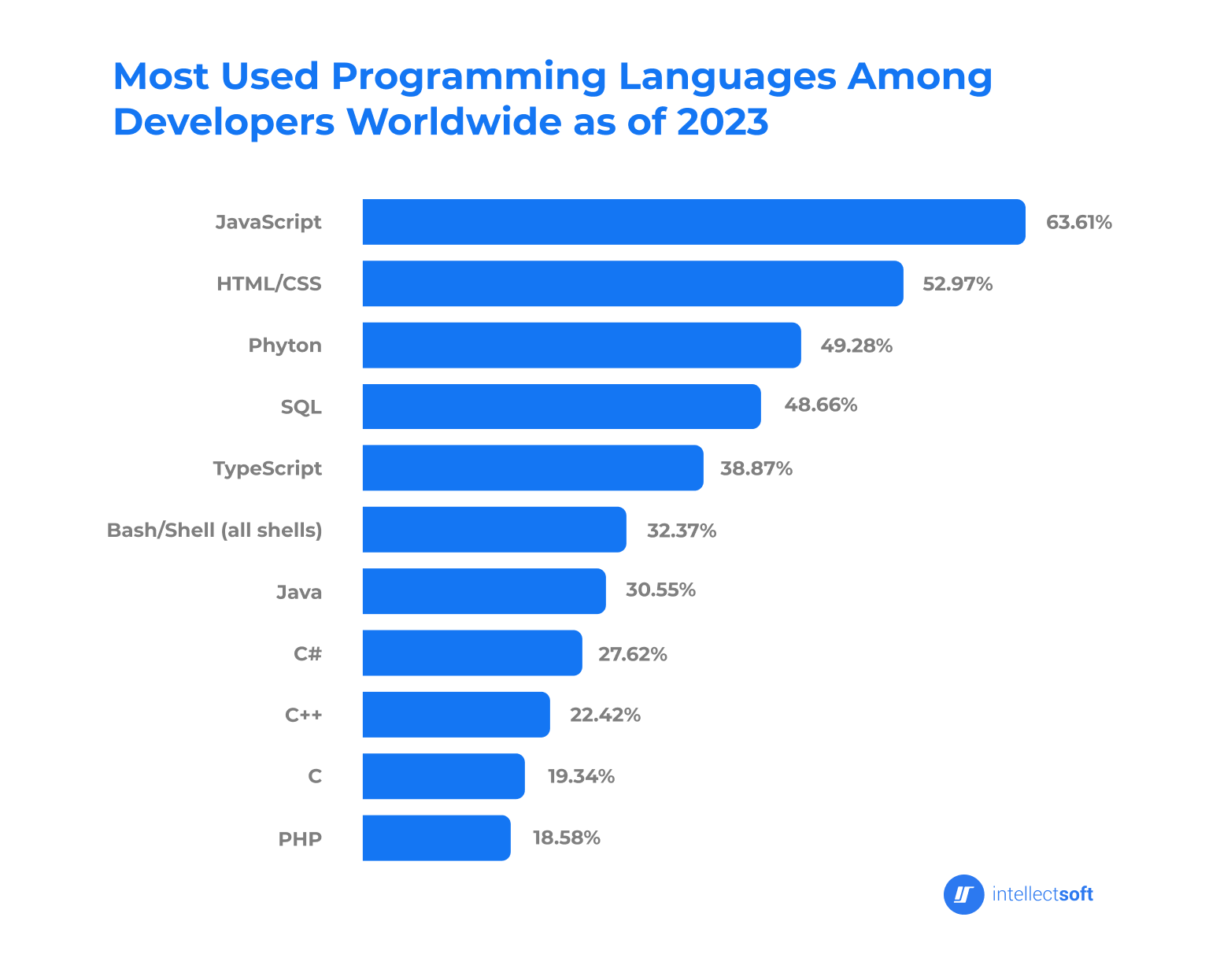
What is Java?
Java is a general-purpose programming language that appeared in 1995 and gradually turned into one of the most demanded tools for software development. Most notably, it became the default language for Android app development. So, the dominant position of Android as the most popular mobile operating system additionally promoted the popularity of Java.
However, Java has many other uses besides mobile app development. This object-oriented language is preferred by web developers and has also proven its efficiency in Big Data and IoT applications.
Key features of Java
The long-lasting popularity of Java is based on its numerous advantages and convenient features. Here are some of them.
- Java is platform-independent. The fundamental principle of this language is “write once, run anywhere.” According to this concept, the compiled code may be easily executed on different platforms and does not require recompilation for this purpose. So, as long as a device can run a Java Virtual Machine, it can run Java code.
- Java creates faster apps. Compared to other languages, Java supports multithreading and has automatic memory management. Thanks to these features, Java applications can use computer hardware more effectively than apps written in Python, for example.
- Java provides more stability and backward compatibility. Since Java is a compiled language with static typing and strict syntax rules, all errors must be eliminated before compilation. That’s why compiled Java apps are more stable and error-free than software written in dynamically typed languages, such as Python.
- Java has a vast and creative community. Thanks to the devoted supporters, Java has a large variety of libraries and frameworks. The community also provides a lot of helpful documentation, education tips, FAQs, and other reference materials to help with coding and learning Java.
Disadvantages of Java
In addition to its numerous advantages, Java also has significant flaws. Below are a few examples.
- Java is “wordy”. Long lines of code are characteristic of this language.
- Java has a complex syntax. It involves the frequent use of curly braces and semicolons and is generally hard to write and read.
- Java is challenging to master. Despite the abundant documentation and learning materials, Java is a more difficult language compared to Python. This is the result of the two drawbacks mentioned above.
- Java apps may require more memory. This language does not have an effective means of garbage collection, so Java apps often can be “RAM-hungry.”
What is Python?
Similar to Java, Python is another highly popular object-oriented programming language. Since its initial release in 1991, Python focused on the simplicity and readability of code. Over the years, this language has proven its incredible versatility in various areas. Currently, Python and its frameworks are commonly used for machine learning, image processing, multimedia applications, and much more.
Key features of Python
Numerous advantages resulted in the growing recognition and affection of the software development community towards Python.
- Python has a simple syntax. It is intuitive due to its similarity to the English language. Python is also very concise, meaning that the lines of code are shorter, and it takes fewer lines to reach an intended result.
- Python promotes fast development. Thanks to the dynamic typing and the overall simplicity of the language, Python software takes less time to write and contains fewer code lines compared to other programming languages.
- Python is easy to learn. This language has a much more comfortable learning curve than Java. It is friendly to beginners thanks to simple syntax, intuitive commands, and a large variety of educational materials.
- Python has very powerful frameworks and libraries. For example, Django and Flask are remarkable web development frameworks, while Tensorflow, Scikit Learn, and Pytorch are excellent for machine learning. Python also has many libraries for scientific computation, data analysis, and other data science applications.
Disadvantages of Python
- Python does not support multithreading. This feature impacts the performance of Python software, making it unable to utilize the full power of modern CPUs.
- Python cannot be used for native mobile app development. This is a serious disadvantage, especially in the context of the “Java vs. Python” comparison. Mobile developers can still use Python with the help of specific libraries, such as PyQt, Kivy, and others. However, unlike Java, Python cannot be used for building native mobile applications.
- Python offers poor database connectivity. Python’s capabilities regarding database access often lack efficiency and require additional modules, such as MySQL Connector Python or PyMySQL. Overall, it can hardly compete with the Database Connectivity API that is included in the Java Standard Edition platform.
What Are the Differences Between Java and Python?
Both Python and Java have much in common as the most popular programming languages. However, their most characteristic features lie in their differences. Let’s take a look at the most prominent distinctions by matching Java vs. Python.
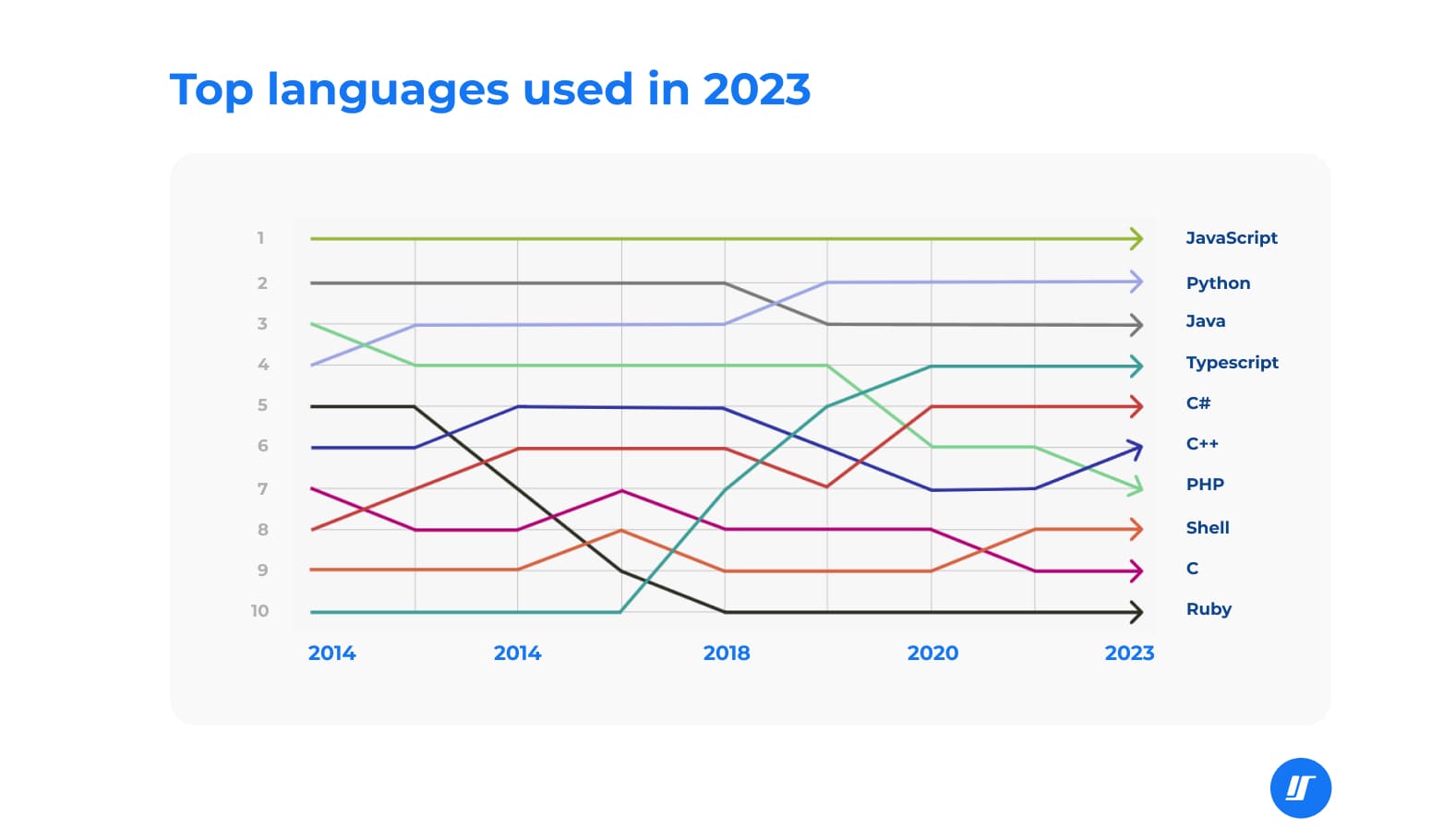
Syntax and Coding Style
As it was mentioned before in this article, Python focuses on readability and simplicity. That’s why its syntax is easy to read and similar to human language. On the other hand, Java has stringent rules that require extensive use of punctuation. Unlike Python, which uses indentation to indicate blocks of code, Java uses a lot of semicolons and curly braces. That’s why syntax is definitely the most noticeable difference between Java and Python.
Coding Speed
Python is more concise and requires fewer lines of code to reach a result. It is dynamically typed, which additionally speeds up the coding process. Java is a statically typed language with a complex syntax, which slows down the speed of code writing. However, the presence of many libraries with ready solutions to many programming tasks makes coding in Java somewhat easier.
App Performance and Stability
Java is a compiled and interpreted language, which means that the code needs to undergo the process of compilation before it can be executed as a program. If there are errors in the code, the compilation will return errors and will not be completed successfully. Since Java programs are compiled and checked for errors before running, they generally perform better in terms of speed and stability than software written in Python.
Python is an interpreted programming language. Unlike Java, its programs are not compiled in advance. This means that any errors in the Python code will show up at runtime, potentially resulting in a program crash.
Learning Curve
Python is famous for being intuitive and simple, which makes it an ideal first programming language to learn. Java is relatively more complex than Python but easier than, for example, C++ and other older languages. Overall, Java is not extremely hard but requires certain experience and understanding of programming principles as a whole.
Even nowadays, many beginners choose Java as their first coding language, though it demands a bit more effort and dedication than Python to master. The abundance of learning courses, educational materials, community forums, and other sources of helpful information makes learning any of these languages exciting and easy.
Java and Python Code Examples
To illustrate differences in syntax, here are two illustrative examples of the code written in Python and Java. This is how both languages handle a basic task: printing a message to a user, also known as a “Hello World” program.
Java:
public class Thank { public static void main(String[] args) { System.out.println("Thanks for reading our blog."); } }
Python:
print("Thanks for reading our blog.")Note that Java needs much more code, including the heavy use of punctuation, than Python to perform the same action: output the message “Thanks for reading our blog.”
Java vs. Python: Which is Better for the Future?
As mentioned earlier in this article, both Python and Java have been among the most popular programming languages for a long time. According to the TIOBE index, Python is currently the top language, while Java is in fourth place. To put this in perspective, the situation was completely opposite five years ago: Java was at the top, and Python was fourth in this rating.
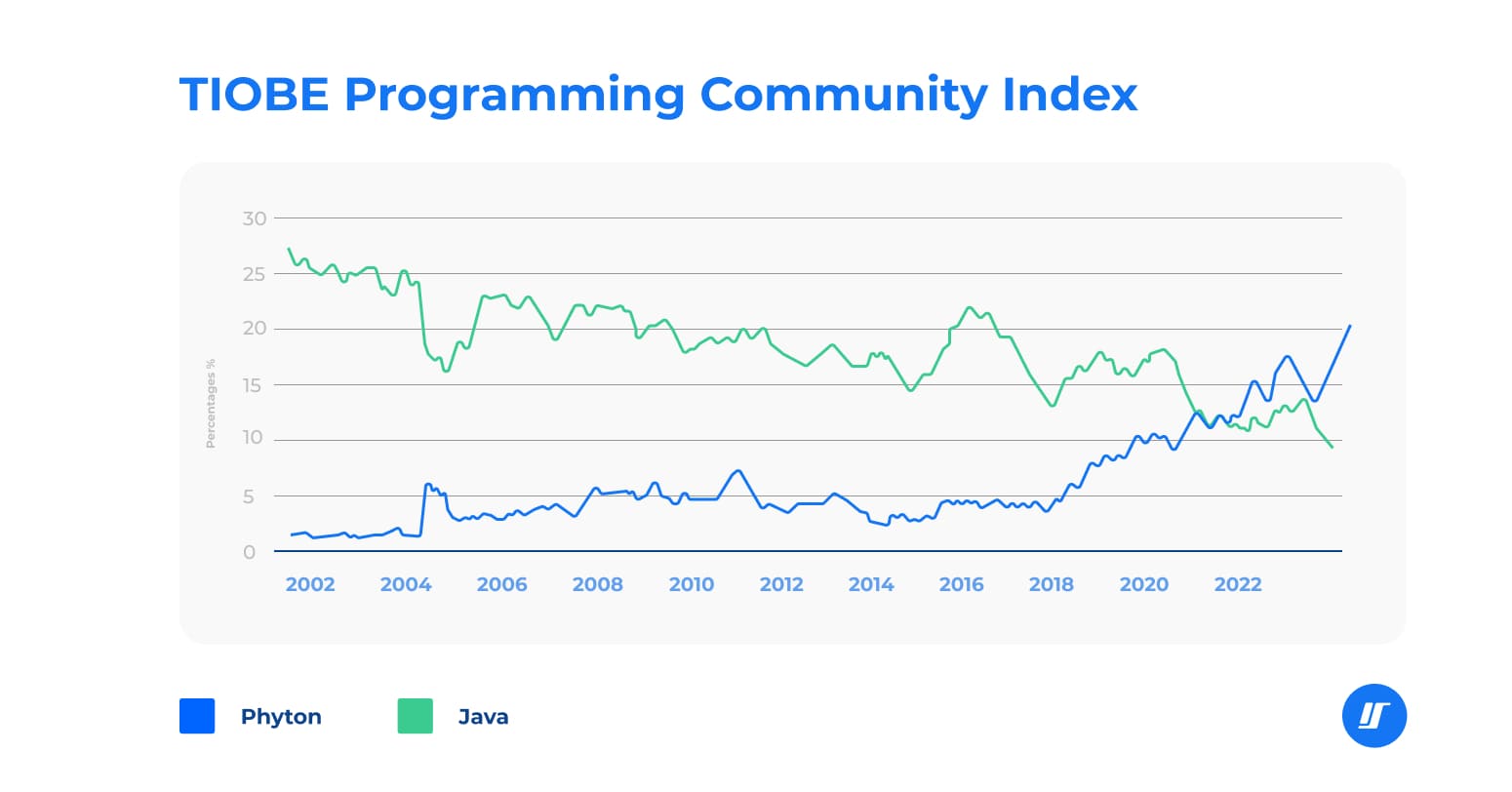
The graphs of the TIOBE index show two trends. First, the overwhelming popularity of Java slowly but steadily declines and has been recently surpassed by other languages. On the other hand, Python’s ratings have been far from impressive for many years. Despite its simplicity and other advantages loved by the programming community, Python’s popularity began to grow significantly only in 2018.
Another helpful indicator from TIOBE is the “Programming Language of the Year” award. During the last decade, Python achieved this title three times: in 2018, 2020, and 2021, while Java got it only once in the past ten years, in 2015.
The annual survey from Stack Overflow shows a similar picture: Python is more popular among both beginners and professional software developers than Java. So, judging by these trends, it is safe to state that Python looks slightly more promising in the future. However, the decline of Java’s popularity is rather small, so this language will definitely remain one of the most demanded development tools in the foreseeable future.
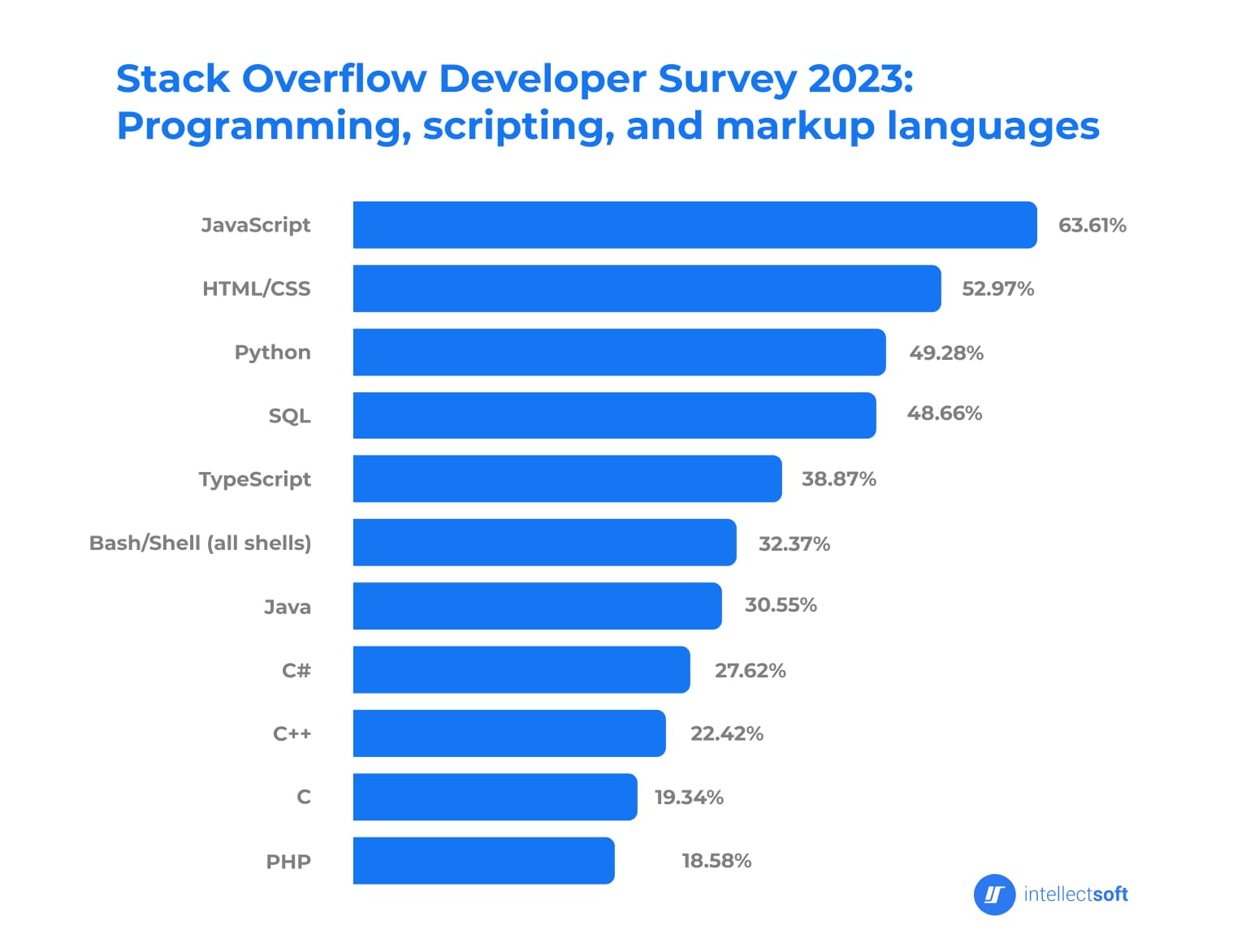
So, What to Choose: Java or Python?
The choice between Python and Java depends on several important factors. The first one is your current experience. If you want to start a career as a software developer, learning Python will be a slightly more optimal choice for you. If you already know a programming language and decide to learn another to increase your potential and improve your professional skills, you can safely pick Java.
Overall, Python is perfect for those who want a quick start in coding, while Java is ideal for enthusiasts who can devote some more time and effort to master a powerful programming tool. This devotion will be rewarded with a higher salary, which is a significant point for consideration.
Another vital factor to consider is the area of implementation for each language. Both Python and Java are general-purpose and object-oriented. However, in practical applications, each of them is effective for some purposes and can be useless for others. Let’s take a look at several use cases for these programming languages.
When to Use Java and Python?
Java is sturdy, fast, and secure. It is widely used in such areas:
- Mobile app development.
- Web app development.
- Big Data.
- Internet of Things.
- Enterprise software development.
Java is a to-go choice when you need to build a cross-platform product with excellent stability and scalability.
Python is concise and flexible. It really shines in the following applications:
- Machine learning.
- Scientific computing.
- Image processing.
- Task automation.
- Multimedia.
Python is invaluable in situations that require rapid deployment and intensive code testing.
Overall, both languages are widely used nowadays for different purposes. Currently, Java developers are in a slightly higher demand among recruits than Python developers.
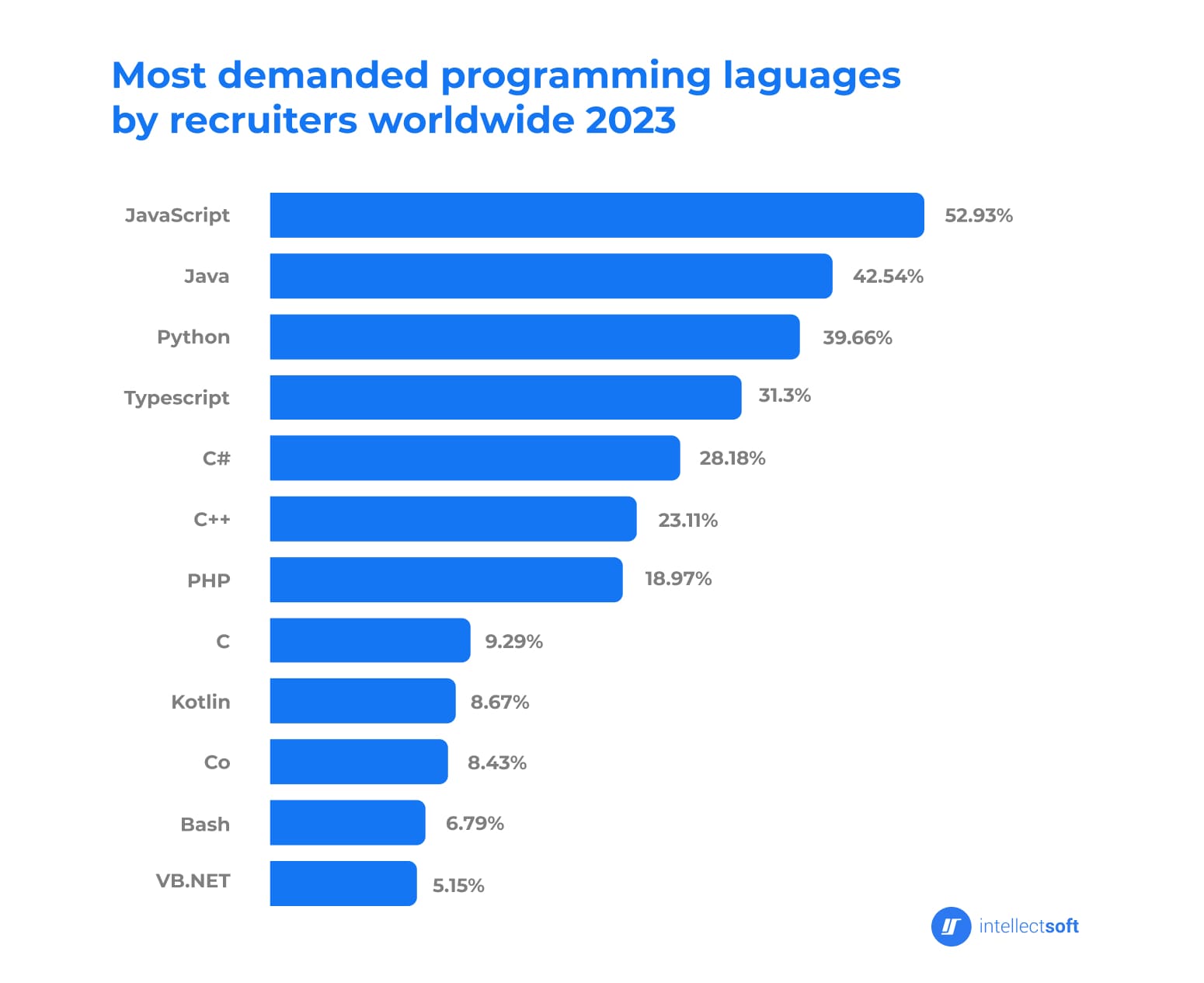
Wrapping Up
Even though Python and Java compete to be the best programming language, the truth is they both can be the best in terms of specific projects. Yes, Java is widely known as an excellent language for creating native mobile apps for Android. However, Python can also be widely used for building the backend side of complex mobile apps.
If you want to start a new web or mobile project and cannot decide between Java and Python, the best thing to do is to consult with a professional software developer or a software engineer. They will listen to your goals, requirements, and needs and suggest the programming language and its frameworks that fit your case perfectly.
As a company with more than 15 years of active experience in providing software development solutions and services to companies across the world, we have many talented experts with solid expertise in both Python and Java. Of course, our talent pool covers dozens of other programming technologies for creating web, mobile, and desktop software. This means we can easily solve all your problems related to the creation of digital products for business.
Over the years, we have delivered over 600 software solutions for businesses of all sizes, from startups to globally renowned enterprises like Intel, Mitsubishi, Harley-Davidson, Young Living, and many more. Our case study section has the most prominent projects that depict our expertise in Python, Java, and other programming technologies.
The domain expertise of Intellectsoft lies primarily in Fintech, Healthcare, and construction. However, we have also successfully delivered digital solutions for businesses in eCommerce, logistics, hospitality, transportation, insurance, and other industries.
So, if you’re looking for a team that will help you choose between Python and Java as well as build you a solid product or renovate your existing one, don’t hesitate to get in touch with us and tell us what you need. Our solution advisor will reach out to you shortly with the most efficient Python- or Java-based solution for your business.
FAQ
Do Java and Python developers have similar salaries?
What is a better language to learn: Python or Java?
If you are new to coding, start with Python. It has a low entry point and a comfortable learning curve. You will achieve a decent level of proficiency in Python much faster than in Java.
Can I use Python and Java for web development?
Yes, you can safely choose either of them for this purpose. Java has always been one of the top picks for backend web development. However, with the help of such frameworks as Django, Flask, CherryPy, and many others, Python can be effectively used for all kinds of web applications.